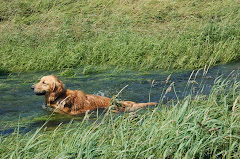Canine Demodicosis
Demodex mites live and fed in the hair follicle and oil glands of the skin. Many dogs have small numbers of Demodex mites in their skin without causing any problems or clinical signs. Demodex mites can cause clinical signs when the host dog is immunocompromised and the mites can reproduce into large numbers. Clinically, demodicosis can present in two form: localized and generalized.
Localized demodicosis occurs in dogs less then two years of age who show signs of irregularly shaped, mildly irritated areas of hairloss. For the most part, the skin is usually not inflammed and only mildly pruritic (itchy). Many cases of localized demodicosis will resolve spontaneously without treatment. Prognosis for this form is good. In contrast, generalized demodicosis is a severe disease. Dogs with the generalized form usually have secondary bacterial infections with systemic disease including lymphadenopathy (enlarged lymph nodes), lethargy, fever and cellulitis. Generalized demodicosis is usually seen in adult dogs with an underlying immune or systemic disease. The underlying disease must be diagnosed for treatment to be effective. Unfortunately, these cases can be difficult to cure.
For the most part, Demodex mites are not considered contagious. However, if a mother has Demodex mites present on her skin, the mites can invade the newborn puppy immediately after birth. If the pup has a normal, healthy immune system, the pup should be able to eliminate the mites. Because of this, young dogs showing clinical signs of demodicosis may have a hereditary predisposition for demodicosis and should not be used for breeding.
Diagnosis
Diagnosis of canine demodicosis is made by perfoming a skin scraping on the affected areas and identifying the demodex mite under a microscrope.  This is a picture of a demodex mite.
This is a picture of a demodex mite.
 This is a picture of a demodex mite.
This is a picture of a demodex mite.Note the elongated, cigar-shaped mite with eight legs. Demodicosis is rare in cats but can occur.
Treatment
Canine demodicosis has been successfully treated with whole body dips. Some of these dips are no longer on the market. Oral ivermectin is successful in treating demodectic mange but should be used cautiously and under the supervision of a veterinarian. Antiparasitic therapy must be continued for 2 consecutive negative skin scrapings.
Canine Scabies
In contrast to Demodex mites, Sarcoptes mites are highly contagious by direct contact between dogs. These mites burrow tunnels into the skin to lay eggs, causing intense pruritis (itching), inflammation and hairloss. The Sarcoptes mite is round, without a distinctive head and they have four pairs of short legs. Sarcoptic mites can infest people causing intense pruritis in pet owners! Dogs with Sarcoptic mites may have raised papules on their skin which develop into thick crusts. Secondary bacterial and yeast infections may result leading to chronic, generalized disease with severe skin thickening if left untreated.
Dogs with Sarcoptic mites may have raised papules on their skin which develop into thick crusts. Secondary bacterial and yeast infections may result leading to chronic, generalized disease with severe skin thickening if left untreated.
 Dogs with Sarcoptic mites may have raised papules on their skin which develop into thick crusts. Secondary bacterial and yeast infections may result leading to chronic, generalized disease with severe skin thickening if left untreated.
Dogs with Sarcoptic mites may have raised papules on their skin which develop into thick crusts. Secondary bacterial and yeast infections may result leading to chronic, generalized disease with severe skin thickening if left untreated. 
Here is a picture of a dog with Sarcoptic mites. Note the reddened, scabby appearance of the skin especially on the pinna (ear flap) of the ears. Sarcoptic mites commonly inhabit the ear flaps of affected dogs.
Diagnosis
Unlike Demodex mites, Sarcoptic mites can be difficult to diagnose from a skin scraping. These mites can be elusive leading to misdiagnosis. Treatment for Sarcoptic mites should be instituted if the history and clinical signs are suggestive.
Treatment
As with canine demodicosis, Sarcoptic mange can be treated successfully with parasitical whole body dips. Oral ivermectin is also successful in treating Sarcoptic mites but should be used cautiously and under the supervision of a veterinarian. A topical parasitical, called Revolution, is approved for the treatment of Sarcoptic mites. Secondary bacterial and yeast infections must also be treated.
So, now you know the difference between the common skin mites that cause mange in dogs. If you are like me, just the thought of these little guys make me itch!











No comments:
Post a Comment